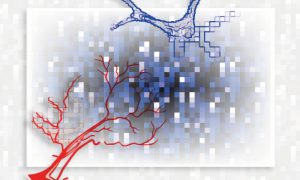16 September 2022

Science & Technology
The latest research from EMBL’s Ikmi group employs interdisciplinary approaches to show how sea anemone ‘exercise’ changes their developing size and shape, uncovering an intimate relationship between behaviour and body development
2022
sciencescience-technology
5 October 2021

Science & Technology
EMBL scientists and colleagues have developed an interactive atlas of the entire marine worm Platynereis dumerilii in its larval stage. The PlatyBrowser resource combines high-resolution gene expression data with volume electron microscopy images.
2021
sciencescience-technology
22 June 2021

Lab MattersPeople & Perspectives
Anna Erzberger, one of EMBL’s newest group leaders, will provide unique perspective as a theoretical biological physicist.
2021
lab-matterspeople-perspectives
1 June 2021

Science & Technology
Captured by EMBL postdoc Arina Rybina, these ‘nuclear twins’ are two daughter nuclei straight after division of a HeLa cell.
2021
picture-of-the-weekscience-technology
2 December 2020

Science & Technology
Scientists in the Diz-Muñoz group at EMBL Heidelberg are working to build understanding of the role that mechanical properties play in affecting cell behaviour – a young and rapidly developing field of study. They have developed and successfully used a highly specialised technique to manipulate…
2020
sciencescience-technology
28 July 2020

Science & Technology
EMBL scientists and collaborators help reveal the process by which enormous quantities of DNA are folded into cells.
2020
sciencescience-technology
12 June 2020

Science & Technology
Scientists discovered that antihypertensive agent alters the tissue characteristics of colon cancer metastases. This "stiffness" of metastases has an effect on the therapeutic success.
2020
sciencescience-technology
20 April 2020

Science & Technology
Researchers from EMBL Heidelberg have created a complete description of early embryo development, accounting for every single cell in the embryo.
2020
sciencescience-technology
7 August 2011

Science & Technology
Researchers can now watch molecules move in living cells, literally millisecond by millisecond, thanks to a new microscope developed by scientists at the European Molecular Biology Laboratory (EMBL) in Heidelberg, Germany. Published online today in Nature Biotechnology, the new technique provides…
2011
sciencescience-technology
17 June 2011

Science & Technology
As any rock-climber knows, trailing a long length of rope behind you is not easy. A dangling length of rope is unwieldy and hard to manoeuvre, and can get tangled up or stuck on an outcropping. Cells face the same problem when dragging chromosomes apart during cell division. The chromosomes are…
2011
sciencescience-technology
5 August 2010
Science & Technology
During cell division, microtubules emanating from each of the spindle poles meet and overlap in the spindle’s midzone. Scientists at the European Molecular Biology Laboratory (EMBL) in Heidelberg, Germany, have uncovered the molecular mechanism that determines the extent of this overlap. In a…
2010
sciencescience-technology
4 July 2010

Science & Technology
The scientists at the European Molecular Biology Laboratory (EMBL) in Heidelberg, Germany, who ‘fathered’ the Digital Embryo have now given it wings, creating the Fly Digital Embryo. In work published today in Nature Methods, they were able to capture fruit fly development on film, and were the…
2010
sciencescience-technology
1 April 2010

Science & Technology
Name a human gene, and you’ll find a movie online showing you what happens to cells when it is switched off. This is the resource that researchers at the European Molecular Biology Laboratory (EMBL) in Heidelberg, Germany, and their collaborators in the Mitocheck consortium are making freely…
2010
sciencescience-technology
2 August 2009
Science & Technology
Chronic inflammatory lung diseases like chronic bronchitis and emphysema are a major global health problem, and the fourth leading cause of death and disability in developed countries, with smoking accounting for 90% of the risk for developing them. Work by scientists at the European Molecular…
2009
sciencescience-technology
25 June 2009

Science & Technology
Researchers at the European Molecular Biology Laboratory (EMBL) in Heidelberg, Germany, came a step closer to understanding how cells close gaps not only during embryonic development but also during wound healing. Their study, published this week in the journal Cell, uncovers a fundamental…
2009
sciencescience-technology
24 February 2009

Science & Technology
‘Useless fish with big eyes’. This is what Medaka, the name of the Japanese killifish in the pictures, means in Japan where it originally comes from. While its eyes are undeniably big, the fish has proven remarkably useful for scientists. It is a simple model organism, amenable to…
2009
sciencescience-technology

















